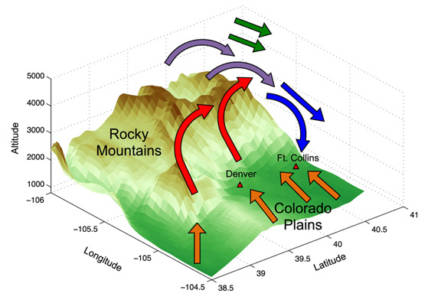Written by Nicole Conlan
Denver and the North Front Range have some of the worst air quality in the country – typically we’re 3rd only to the greater Los Angeles area and California’s Central Valley. In the summer of 2021, our air quality was ranked among the worst on Earth. And while the summer’s poor air quality was attributable in part to wildfire smoke blown in from California, our air quality issues persist even under normal circumstances. The greenhouse gases (GHG) that cause climate change are a global problem – CO2 emitted in Denver contributes to warming in Nepal. But Colorado’s air pollution is also a specifically local issue. A combination of geography and chemistry results in the front range’s “brown cloud” that can often be seen around Denver’s skyline. And while the brown cloud has improved significantly since its worst point in the 1960s and 70s, our air quality issues are ongoing – and they’ve spread from city centers to our most pristine wilderness. Read on to learn more about what causes this problem and what Colorado is doing about it.
What’s In The Air
Air pollution consists of tiny particles, smaller than the width of a human hair, which create negative health and environmental outcomes. There are many chemicals that qualify as pollutants, but EPA lists 6 “criteria” air pollutants with human-health and environmental standards for regulation: Carbon Monoxide, Ozone, Lead, Nitrogen Oxides, Particulate Matter, and Sulfur Dioxide. All these pollutants are produced from industrial sources and automobiles.
To address these pollutants, the Clean Air Act was enacted in 1963 and has been amended many times since. The Clean Air Act’s regulations helped eliminate much of the airborne pollution across the country. However, Denver now consistently violates Clean Air Act requirements, largely because of our difficulties managing ozone.
In the highest parts of the atmosphere, ozone protects us from the sun’s UV rays, but at ground level, it can cause respiratory problems like shortness of breath, coughing, and inflamed airways. Long-term exposure to ozone can cause asthma and an increased likelihood of death from respiratory causes.
Ozone is created when two pollutants called nitrogen oxides (NOx) and volatile organic compounds (VOCs) are exposed to sunlight. Ozone itself is invisible, but the ingredients it requires are found in the brown cloud. That means days with high levels of ozone are often the smoggiest. And unfortunately, Colorado is the perfect place to generate and circulate ozone.
Ozone can be made 10-20% worse in smoke (or sometimes better, even), but the region’s air pollution problems are solidly caused by combustion vehicle emissions and releases from fracking, with fossil fuel processing (e.g., Suncor) and transport forming part of the last 10%.
Front Range Geography – A Breeding Ground For A Brown Cloud
A combination of topography and chemistry results in poor air quality on the front range. Wind blows away from the mountains, which ordinarily disperses pollutants over the Eastern plains. But summer heat, exacerbated by heat from Denver’s infrastructure, creates a mass of warm air that can temporarily reverse this wind pattern, sending pollutants towards the mountains. Then when the air cools at night, winds return to normal, and the pollutants blow back over Denver again. Depending on weather patterns, the same pollutants can circle through the city multiple times. As climate change worsens, these kind of temperature inversions will contribute to worsening air quality in Colorado, especially along the front range.

Under certain conditions, upslope flow (orange arrows) draws air from the plains, across the Colorado Front Range. This airflow sweeps pollutants from Denver upwind toward the foothills where they accumulate (red arrows) at higher elevations. This elevated flow (purple arrows) interacts with westerly winds (green arrows) and recirculates slightly north and back downward. The polluted air (blue arrows) can then mix downward over the Front Range. (Courtesy J. T. Sullivan, et al., 2016, Journal of Geophysical Research: Atmospheres)
When it comes to ozone, Colorado also has particular disadvantages. The chemical reaction that creates ozone is powered by the sun, and there’s a lot of that to go around in a state that famously has 300 days of sun a year. Colorado also has large sources of the chemicals that make ozone – NOx is largely produced from agricultural sites like those in Greely and the eastern plains, and VOCs come from combustion, both in the cars of our rapidly-growing population as well as at industrial locations like fracking wells and the Suncor Oil Refinery.
Some of our high ozone concentration is also a bit of geological bad luck. Occasionally, conditions in the upper atmosphere can create off-ramps for atmospheric ozone to come to ground-level. These off-ramps are more likely to occur in high-altitude cities, like Denver and the front range. That means our background level of ozone is higher than the country’s average – which means we have less wiggle room to generate more ozone before we hit unhealthy levels.
How We’re Taking Action
Thanks to strengthened national air quality standards, Colorado’s air has improved in recent decades. However, most of the low-hanging fruit, such as improving vehicle emissions standards, has already been implemented. Now, the oil and gas industry is the most important target if we are to reduce airborne pollutants, especially ozone. 350 Colorado is spearheading campaigns against the Suncor oil refinery and fracking in Colorado, both of which are major contributors to our poor air quality.
Furthermore, 350’s overall mission to combat climate change is essential to reducing the frequency of giant, devastating wildfires whose smoke has contributed heavily to poor air quality in recent years. You can find out about all our efforts to fight climate change at our campaigns page.
And to check air quality in your area, visit the government’s air quality website.
